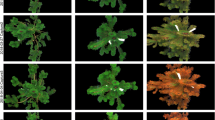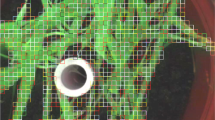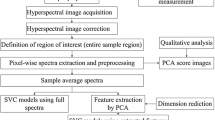Abstract
Background and Aims
Explosives released into the environment from munitions production, processing facilities, or buried unexploded ordnances can be absorbed by surrounding roots and induce toxic effects in leaves and stems. Research into the mechanisms with which explosives disrupt physiological processes could provide methods for discrimination of anthropogenic and natural stresses. Our objectives were to experimentally evaluate the effects of natural stress and explosives on plant physiology and to link differences among treatments to changes in hyperspectral reflectance for possible remote detection.
Methods
Photosynthesis, water relations, chlorophyll fluorescence, and hyperspectral reflectance were measured following four experimental treatments (drought, salinity, trinitrotoluene and hexahydro-1,3,5-trinitro-l,3,5-triazine) on two woody species. Principal Components Analyses of physiological and hyperspectral results were used to evaluate the differences among treatments.
Results
Explosives induced different physiological responses compared to natural stress responses. Stomatal regulation over photosynthesis occurred due to natural stress, influencing energy dissipation pathways of excess light. Photosynthetic declines in explosives were likely the result of metabolic dysfunction. Select hyperspectral indices could discriminate natural stressors from explosives using changes in the red and near-infrared spectral region.
Conclusions
These results show the possibility of using variations in energy dissipation and hyperspectral reflectance to detect plants exposed to explosives in a laboratory setting and are promising for field application using plants as phytosensors to detect explosives contamination in soil.






Similar content being viewed by others
References
Ali NA, Dewez D, Robidoux PY, Popovic R (2006) Photosynthetic parameters as indicators of trinitrotoluene (TNT) inhibitory effect: Change in chlorophyll a fluorescence induction upon exposure of Lactuca sativa to TNT. Ecotoxicol 15:437–441
Best EPH, Tatem HE, Geter KN, Wells ML, Lane BK (2008) Effects, uptake, and fate of 2,4,6-trinitrotoluene aged in soil in plants and worms. Environ Toxicol Chem 27:2539–2547
Brentner LB, Mukherji ST, Walsh SA, Schnoor JL (2010) Localization of hexahydro-1,3,5-trinitro-1,3,5-triazine (RDX) and 2,4,6-trinitrotoluene (TNT) in poplar and switchgrass plants using phosphor imager autoradiography. Environ Pollut 158:470–475
Campbell PE, Middleton EM, Corp LA, McMurtrey JE, Chappelle EW (2007) Comparison of foliar fluorescence and reflectance measurements for the detection of vegetation stress. J Environ Qual 36:32–845
Castro KL, Sánchez-Azofeifa GA (2008) Changes in spectral properties, chlorophyll content and internal mesophyll structure of senescing Populus balsamifera and Populus tremuloides leaves. Sensors 8:51–69
Chaves MM, Pereira JS, Maroco J, Rodrigues ML, Ricardo CPP, Osório ML, Carvalho I, Faria T, Pinheiro C (2002) How plants cope with water stress in the field: photosynthesis and growth. Ann Bot-London 89:907–916
Chaves MM, Flexas J, Pinheiro C (2009) Photosynthesis under drought and salt stress: regulation mechanisms from whole plant to cell. Ann Bot 103:551–560
da Silva M, Arrabaça MC (2004) Photosynthesis in the water stressed C4 grass Setaria sphacelata is mainly limited by stomata with both rapidly and slowly imposed water deficits. Physiol Plantarum 121:409–420
Downton WJS, Loveys BR, Grant WJR (1990) Salinity effects on the stomatal behavior of grapevine. New Phytol 116:499–503
Ehrenfeld JG (1990) Dynamics and processes of barrier island vegetation. Rev Aquat Sci 2:437–480
Flexas J, Medrano H (2002) Energy dissipation in C3 plants under drought. Funct Plant Biol 29:1209–1215
Flexas J, Escalona JM, Medrano H (1999) Water stress induces different photosynthesis and electron transport rate regulation in grapevine. Plant Cell Environ 22:39–48
Flexas J, Escalona JM, Evain S, Gulías J, Moya I, Osmond CB, Medrano H (2002) Steady-state chlorophyll fluorescence (Fs) measurements as a tool to follow variations of net CO2 assimilation and stomatal conductance during water-stress in C3 plants. Physiol Plantarum 114:231–240
Flexas J, Bota J, Loreto F, Cornic G, Sharkey TD (2004) Diffusive and metabolic limitations to photosynthesis under drought and salinity in C3 plants. Plant Biol 6:269–279
Gamon JA, Peñuelas J, Field CB (1992) A narrow-waveband spectral index that tracks diurnal changes in photosynthetic efficiency. Remote Sens Environ 41:35–44
Gamon JA, Serrano L, Surfus JS (1997) The photochemical reflectance index: an optical indicator of photosynthetic radiation use efficiency across species, functional types, and nutrient levels. Oecologia 112:492–501
Garbulsky MF, Peñuelas J, Gamon J, Inoue Y, Filella I (2011) The photochemical reflectance index (PRI) and the remote sensing of leaf, canopy and ecosystem radiation use efficiencies. Remote Sens Environ 115:281–297
Gitelson AA, Merzlyak MN (1996) Signature analysis of leaf reflectance spectra: algorithm development for remote sensing of chlorophyll. J Plant Physiol 148:94–500
Harvey S, Fellows RJ, Cataldo DA, Bean RM (1991) The fate of the explosive hexahydro-1,3,5-trinitro-1,3,5-triazine (RDX) in soil and bioaccumulation in bush bean hydroponic plants. Environ Toxicol Chem 10:845–855
Kalderis D, Juhasz AL, Boopathy R, Comfort S (2011) Soils contaminated with explosives: environmental fate and evaluation of state-of the-art remediation processes (IUPAC Technical Report). Pure Appl Chem 83:1407–1484
Komoβa D, Langebartels C, Sandermann H Jr (1995) Metabolic processes for organic chemicals in plants. In: Trapp S, McFarlane JC (eds) Plant contamination: modeling and simulation of organic chemical processes. CRC Press Inc, Boca Raton, pp 69–103
Krishnan G, Horst GL, Darnell S, Powers WL (2000) Growth and development of smooth bromegrass and tall fescue in TNT-contaminated soil. Environ Pollut 10:109–116
Medina VF, McCutcheon SC (1996) Phytoremediation: modeling removal of TNT and its breakdown products. Remediation 6:31–45
Medina VF, Maestri E, Marmiroli M, Dietz AC, McCutcheon SC (2003) Plant tolerances to contaminants. In: McCutcheon SC, Schnoor JL (eds) Phytoremediation: transformation and control. Wiley, Hoboken, pp 189–232
Morales F, Abadía A, Abadía J (2006) Photoinhibition and photoprotection under nutrient deficiencies, drought and salinity. In: Demmig-Adams B, Adams WW, Mattoo AK (eds) Photoprotection, photoinhibition, gene regulation, and environment. Springer, Dordrecht, pp 65–85
Munns R (2002) Comparative physiology of salt and water stress. Plant Cell Environ 25:239–250
Naumann JC, Young DR, Anderson JE (2007) Linking leaf chlorophyll fluorescence properties to physiological responses for detection of salt and drought stress in coastal plant species. Physiol Plantarum 131:422–433
Naumann JC, Anderson JE, Young DR (2010) Remote detection of plant physiological responses to TNT soil contamination. Plant Soil 329:239–248
Ogaya R, Peñuelas J (2003) Comparative field study of Quercus ilex and Phillyrea latifolia: photosynthetic response to experimental drought conditions. Environ Exp Bot 50:137–148
Pilon-Smits E (2005) Phytoremediation. Annu Rev Plant Biol 56:15–39
Redondo-Gómez S, Wharmby C, Castillo JM, Mateos-Naranjo E, Luque C, de Cires A, Luque T, Davy AJ, Figueroa ME (2006) Growth and photosynthetic responses to salinity in an extreme halophyte, Sarcocornia fruticosa. Physiol Plantarum 128:116–124
Robidoux PY, Bardai G, Paquet L, Ampleman G, Thiboutot S, Hawari J, Sunahara I (2003) Phytotoxicity of 2,4,6-trinitrotoluene (TNT) and octahydro-1,3,5,7-tetranitro-1,3,5,7-tetrazocine (HMX) in spiked artificial and natural forest soils. Arch Environ Contam Toxicol 44:198–209
Sens C, Scheidemann P, Werner D (1999) The distribution of 14C – TNT in different biochemical compartments of the monocotyledonous Triticum aestivum. Environ Pollut 104:113–119
Verkleij JOS, Golan-Goldhirsh A, Antosiewisz DM, Schwitzguébel J-P, Schröder P (2009) Dualities in plant tolerance to pollutants and their uptake and translocation to the upper plant parts. Environ Exp Bot 67:10–22
Vila M, Lorber-Pascal S, Laurent F (2007) Fate of RDX and TNT in agronomic plants. Environ Pollut 148:148–154
Winfield LE, Rodger JH, D’Surney SJ (2004) The responses of selected terrestrial plants to short (<12 days) and long term (2, 4 and 6 Weeks) hexahydro-1,3,5-trinitro-1,3,5-triazine (RDX) exposure. Part I: growth and developmental effects. Ecotoxicology 13:335–347
Young DR, Erickson DL, Semones SW (1994) Salinity and the small-scale distribution of three barrier island shrubs. Can J Bot 72:1365–1372
Zarco-Tejada PJ, Miller JR, Mohammed GH, Noland TL, Sampson PH (2000) Chlorophyll fluorescence effects on vegetation apparent reflectance. II. Laboratory and airborne canopy-level measurements with hyperspectral data. Remote Sens Environ 74:596–608
Zarco-Tejada PJ, Miller JR, Mohammed GH, Noland TL, Sampson PH (2001) Estimation of chlorophyll fluorescence under natural illumination from hyperspectral data. Int J Appl Earth Obs Geoinf 3:321–327
Zarco-Tejada PJ, Miller JR, Mohammed GH, Noland TL, Sampson PH (2002) Vegetation stress detection through chlorophyll a + b estimation and fluorescence effects on hyperspectral imagery. J Environ Qual 31:1433–1441
Zarco-Tejada PJ, Berni JAJ, Suárez L, Sepulcre-Cantó G, Morales F, Miller JR (2009) Imaging chlorophyll fluorescence with an airborne narrow-band multispectral camera for vegetation stress detection. Remote Sens Environ 113:1262–1275
Zinnert JC (in press) Plants as phytosensors: physiological responses of a woody plant in response to RDX exposure and potential for remote detection. Int J Plant Sci
Zinnert JC, Nelson JD, Hoffman AM (2012) Effects of salinity on physiological responses and the photochemical reflectance index in two co-occurring coastal shrubs. Plant Soil 354:45–55
Acknowledgments
The authors thank Jared Austin and Jarrod Edwards for assistance in data collection. This research was supported by internal basic research program funds from the U.S. Army Corps of Engineers/Engineer Research and Development Center (ERDC) and (in part) by the U.S. Army RDECOM ARL Army Research Office under grant W911NF-06-1-0074.
Author information
Authors and Affiliations
Corresponding author
Additional information
Responsible Editor: Juan Barcelo.
Rights and permissions
About this article
Cite this article
Zinnert, J.C., Via, S.M. & Young, D.R. Distinguishing natural from anthropogenic stress in plants: physiology, fluorescence and hyperspectral reflectance. Plant Soil 366, 133–141 (2013). https://doi.org/10.1007/s11104-012-1414-1
Received:
Accepted:
Published:
Issue Date:
DOI: https://doi.org/10.1007/s11104-012-1414-1




